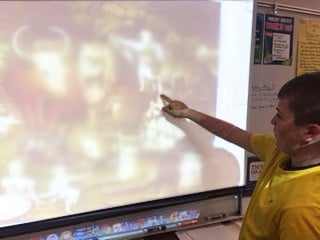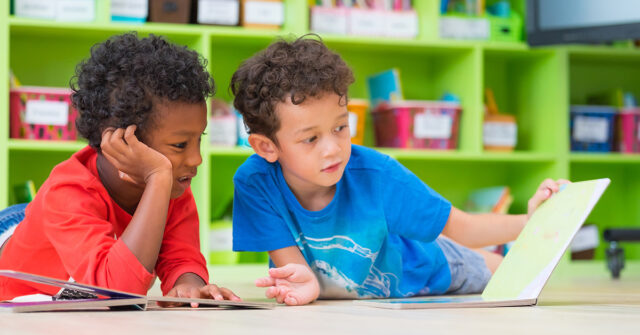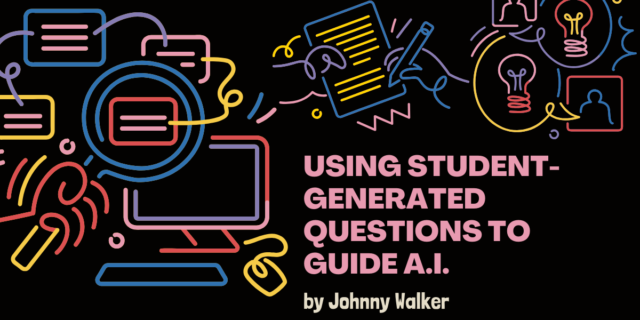
| “Visible Thinking has a double goal: on the one hand, to cultivate students’ thinking skills and dispositions, and, on the other, to deepen content learning. By thinking dispositions, we mean curiosity, concern for truth and understanding, a creative mindset, not just being skilled but also alert to thinking and learning opportunities and eager to take them.” (visiblethinkingpz.org) |
Too often, I have been guilty of repeating my old story as a teacher—the story where I play the lecturer or spoon-feeder of information, and students take down notes ferociously without processing or sharing their understanding, curiosity, or emotional responses. Weeks later, on a test, I find out what they understood or didn’t.
It is time to change my teaching story.
As I have reported in earlier blogs, I am working on an action research project focusing on how teachers and children can make thinking visible through the use of simple thinking routines that promote deep thinking, engagement, and independence in the classroom. (See Project Zero’s Thinking Routines video.) Here’s an example:
See / Think / Wonder
| A routine for exploring works of art and other interesting things • What do you see? • What do you think about that? • What does it make you wonder? |
 On January 10, my birthday, my fifth-grade class was preparing for a trip to the de Young Museum in San Francisco to see paintings that would enhance our study of the American colonies. As a precursor to the museum visit, we analyzed the painting The Peaceable Kingdom by Edward Hicks using the See Think Wonder routine. I hoped this painting would add another perspective to their understanding of the relationship between the Native Americans and the colonists.
On January 10, my birthday, my fifth-grade class was preparing for a trip to the de Young Museum in San Francisco to see paintings that would enhance our study of the American colonies. As a precursor to the museum visit, we analyzed the painting The Peaceable Kingdom by Edward Hicks using the See Think Wonder routine. I hoped this painting would add another perspective to their understanding of the relationship between the Native Americans and the colonists.
My students stepped into action in the See portion of this thinking routine. They already knew the routine, and I merely got them started. For the next fifteen minutes they observed closely and shared their observations of the details in the painting. Students waved their hands with excitement, wanting to express the details they saw that others didn’t. Others murmured, “Oh, wow! I didn’t see that.” As children pushed their hands in front of my face, frustrated when I didn’t call on them, I nudged the discussion in the direction of some carefully posed questions. “So what do you think the painter is trying to express? What is the story he is trying to tell? How does this connect to or extend what you understand up to this point about the relationship between the Europeans and Native Americans? How does the painter’s point of view influence how events are perceived? What is it that makes you say that?”
As we moved to the Think portion, an argument started, and students jumped out of their chairs wanting to take a side. One student suggested the painter was trying to use the animals (the wild next to the tame) as a metaphor for the tension between the Native Americans and the Europeans. A different student thought the painter was trying to reveal a peaceful relationship, pointing out the name of the painting was The Peaceable Kingdom. I have found history can be hard for many students to connect with, and I was moved by their unusual engagement in the lesson and by the larger-than-usual number of people who needed to share their thinking, wanted to get involved, and listened to the opinions of others. I was pleased to see one of our quiet students had his hand up constantly, and one of his observations invited compliments and add-ons from one of the more outspoken students.
 When we began recording our Wonder questions, students were just as eager to share their thoughts. Because students shared different interpretations and I had been clear I wasn’t sure what the painter was trying to express, they seemed more comfortable than usual about raising questions: “Who were the people? What were they talking about? What was the document they were holding? Where did this take place? Why were the animals there so close to one another (the wild and the tame)?” Ending the lesson with the students truly curious was a perfect way to set them up for their visit to the museum.
When we began recording our Wonder questions, students were just as eager to share their thoughts. Because students shared different interpretations and I had been clear I wasn’t sure what the painter was trying to express, they seemed more comfortable than usual about raising questions: “Who were the people? What were they talking about? What was the document they were holding? Where did this take place? Why were the animals there so close to one another (the wild and the tame)?” Ending the lesson with the students truly curious was a perfect way to set them up for their visit to the museum.
While I study how teaching students to be metacognitive supports independence and engagement in learning, it is important that I make explicit and model the thinking moves they will use in this and many other lessons. (See Ron Ritchhart’s Understanding Map for some of the major thinking moves we focus on in class.) Students will practice making careful observations, uncovering thoughtful interpretations, and building curiosity. Making the thinking goals explicit empowers students and helps them understand my expectations and values around the importance of thinking to learn. As one student said, “I never understood when teachers used to tell us to go deeper; now I get how to do it.”
As I listened and recorded their thinking that winter day, I was amazed at what was happening in my room. It was exhilarating to see how a simple thinking routine could support such active participation and independence. My role was to make room for all voices and support them in making their thoughts visible to one another so they could experience the value of collaborative learning. The students’ actions and engagement revealed to me that learning is truly a social endeavor. After the lesson, a few students shared their reflections on this learning process:
“This way of learning keeps me awake. It is hard to listen when a lot is thrown at me. I’ll remember better because of our discussion.”
“When we share, it gets more interesting.”
“I like it because if I have something to say, I just have to say it, and it keeps me engaged.”
At the end of the lesson, with a sincere smile, I expressed my awe at the depth of their observations, their discussions, and the thinking language they were using. It was at that moment when one girl raised her hand and, with a huge grin, looked into my eyes and said quietly, “Happy birthday, Ms. Scott.”
♦ ♦ ♦
Supporting students to engage in thinking to learn is the heart of my work. My goal in this lesson was to push them as thinkers through careful and specific questioning that led them to uncover their own learning. I noticed students were showing metacognitive awareness as they verbalized the kinds of thinking moves they were making. “When I looked closely I saw . . . This makes me think . . . I wonder . . . I can connect to . . . I say this because . . . I am puzzled by . . . The painter’s viewpoint seems to be . . . .At the heart of this painting is . . . I think this represents . . . I want to find out more about . . . ”
Growing understanding is as much an active, creative, and collective endeavor as it is an individual process. As students are pressed to think and make their thoughts visible through the simple steps of thinking routines and guiding questions I pose, I become more of a documenter of their ideas and learning, using their information to guide my teaching as well as assess their understanding. With this shift in the way I teach, I am starting to see students empowered by their new role in learning, as they go from passive receivers of information to active knowledge creators.
 Hollis’ pedagogy is steeped in an emphasis on interdisciplinary learning, global citizenship, and visible thinking. “There is a social and ethical component to being a good teacher. Students need to learn how to be good individuals, citizens, and workers. They need to reflect and engage thoughtfully in conversations about social issues and how to take action, even if it is with simple acts of kindness.” Hollis is a 5th Grade Teacher at Montair Elementary School in Danville, California.
Hollis’ pedagogy is steeped in an emphasis on interdisciplinary learning, global citizenship, and visible thinking. “There is a social and ethical component to being a good teacher. Students need to learn how to be good individuals, citizens, and workers. They need to reflect and engage thoughtfully in conversations about social issues and how to take action, even if it is with simple acts of kindness.” Hollis is a 5th Grade Teacher at Montair Elementary School in Danville, California.
header photo by: Aaina Sharma


